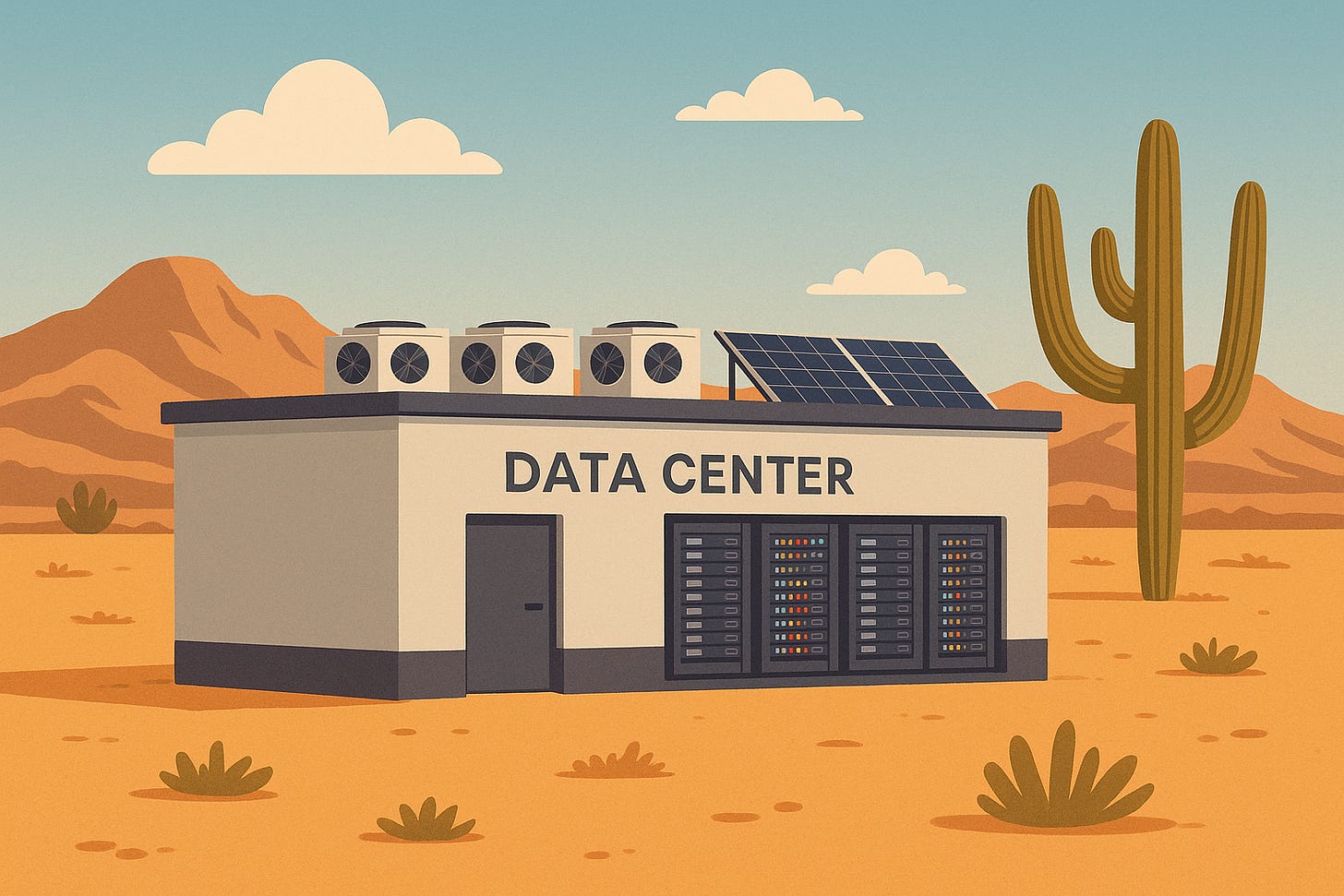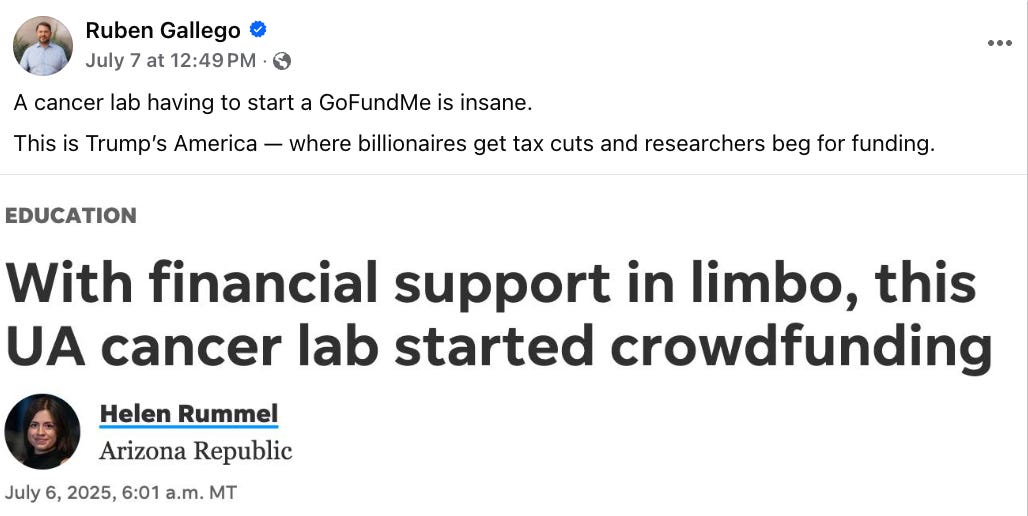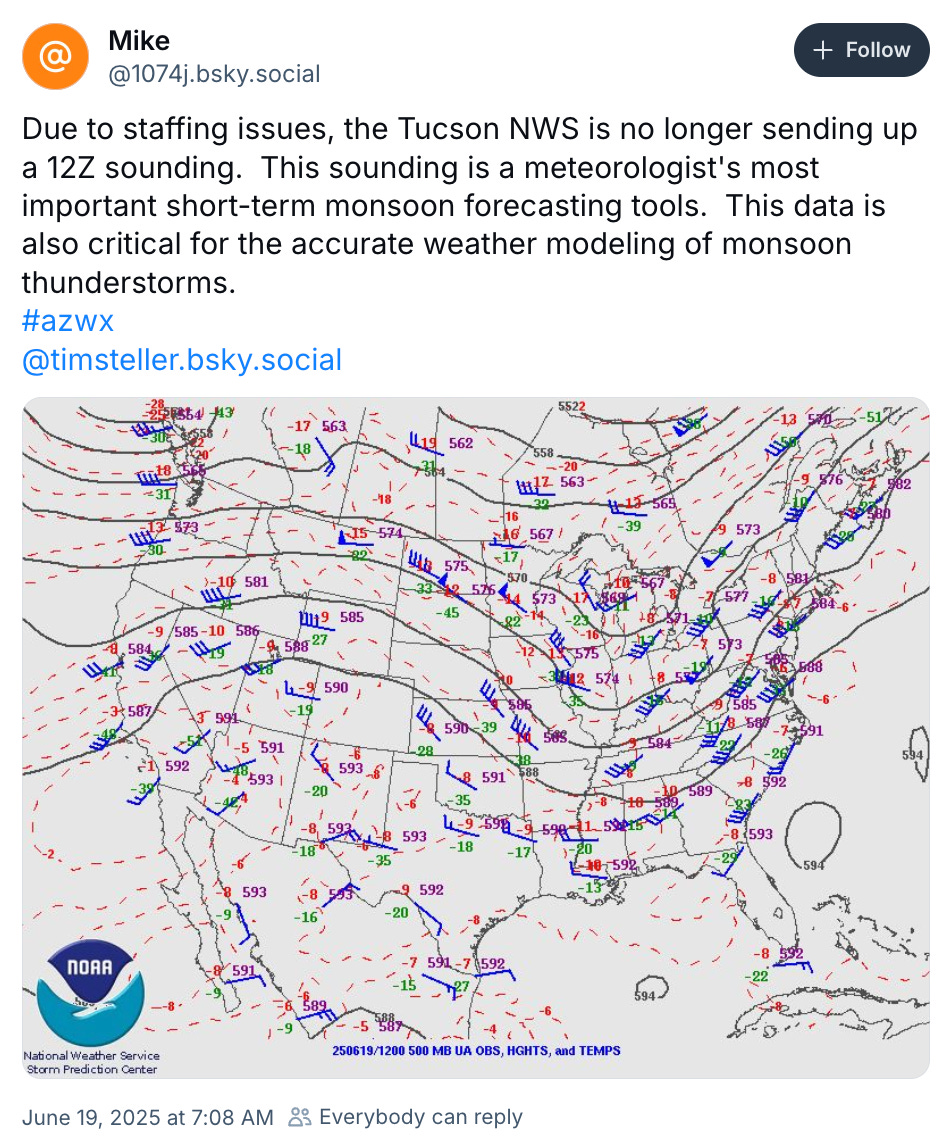37 pages of questions
Data in the desert … A last-minute CD7 PSA … And, yes, it is an unscientific report.
A few hours after the City of Tucson made good on its promise to release a draft development agreement with the “developer” of Project Blue, the reaction from individual members of the Tucson City Council wasn’t great.
Councilwoman Nikki Lee, who has more than 25 years of experience in the tech industry and holds an MBA in IT Management, said the development agreement has her stumped.
“After reviewing this draft, I now have more questions than answers,” Lee told us. “I’m especially concerned about how key water provisions would be enforced and whether they truly protect Tucson’s long-term water supply. Air quality hasn’t been addressed at all. Economic benefits remain vague. And there are still a lot of missing or unclear details.”
Councilman Paul Cunningham was underwhelmed by the proposal.
“I applaud their efforts of releasing some information and specifics about the project. Despite this new information, I still retain the same amount of skepticism that I’ve had before. I’m not comfortable with all the cloak and dagger stuff that precluded this process. Therefore, I’m still not comfortable moving this project forward,” he said.
Councilwoman Karin Uhlich also came out with a long list of questions in her newsletter on Monday, including implementing guardrails for data centers.
“Combined with the Arizona Corporation Commission’s plans to review/regulate (data centers, it) can guide us toward guardrails we (and the state) need to have in place before/if we deliberate further on any specific projects,” she wrote.
Note the “if” clause in her statement.
And one more statement for good measure. Councilman Kevin Dahl made it clear in his last newsletter, he isn’t a fan.
”(A)t this point, I am a ‘strong no’ to approving the annexation,” he wrote yesterday.
Those four make a majority of the city council expressing real concerns about moving forward with allowing Project Blue to set up shop here in Tucson. The rule of thumb is get to four “yes” votes on a seven-member board when you want to get something done.
The reality is that despite a 37-page agreement packed with details, members of the council still have lots of reasons to be spooked.
We still don’t even know who is really behind Project Blue, for example. The agreement references the end user’s already-disclosed proxy: San Francisco-based Humphrey’s Peak LLC.
The agreement also outlines three key stages of development: an “initial phase,” where several data centers will be built on the 290-acre site on the city’s southeast side; a “full build” of that same site; and a secondary project elsewhere inside city limits that is also referred to as part of the “full build.”
Not to be an alarmist, but the second project is even bigger than the 290-acre “primary project” we’ve been calling Project Blue. The secondary project needs more water and more energy — and presumably, more land.
The initial phase is expected to be online by 2027.
Let’s start with water
During the initial phase, the site would use 440 acre-feet per year, roughly 143 million gallons annually.
In several years when the project is fully built-out across both sites — if the Tucson City Council approves it later this year — the agreement anticipates Project Blue will use more than four times as much water — 1,910 acre-feet per year.
To put that in context: Using the city’s estimates that 80% of Tucson households use ~90,000 gallons per year, Project Blue’s two projects would consume as much water as 3,765 Tucson homes. Put another way, that’s about the same amount of water as three 18-hole golf courses, according to the city.
The developer will pay the base rate for water at this tier, plus a $750 per acre-foot “water positivity” fee, which goes into city coffers.
The agreement also allows the developer to earn water credits by working with other users in the region to reduce their usage. That could mean projects like partnering with Pima Community College to remove turf on one of its campuses, for example, Tucson City Manager Tim Thomure — a former director of Tucson Water — told us.
If Project Blue uses more water than anticipated, additional fees could be triggered, including “liquidated damages.”
Thomure said it’s unclear whether the city could simply “turn off the tap” if Project Blue were in gross breach of contract. Those terms are still being negotiated and could be revised to add stronger enforcement provisions.
“I need to find out is there an absolute, ‘none shall pass this point,’ on how much water use there is. I mean, it's constrained by the ability of the infrastructure to deliver water and the size of their meters,” he told the Tucson Agenda.
Infrastructure investments
The developer has committed to spending $100 million on Tucson Water infrastructure improvements, including building an 18-mile reclaimed water pipeline to serve the data centers. That includes associated infrastructure, like pumping stations and a recharge/reclaim facility.
Project Blue will use potable water until the “purple pipe” system for reclaimed water is in place. The city is giving the developer up to two years to complete construction, per the draft agreement.
Tucson officials say they have enough capacity to supply reclaimed water. By 2026, the city expects to have access to 32,000 acre-feet per year — 22,000 AFY from treated sewage and another 10,000 AFY from the TARP plant — far more than enough to feed Project Blue’s total expected demand of 1,900 acre-feet.
To achieve its “water positive” branding, Project Blue has agreed to support an ambitious strategy to offset its daily use of millions of gallons of reclaimed water.
It is a combination of improvements to the TARP plant, fixing and replacing old leaking pipes and working with non-profits to help low-income residents make the switch to more efficient, less thirsty plumbing.
And now: the energy
The development agreement also outlines Project Blue’s expected energy usage, though this will largely be managed through a separate agreement with Tucson Electric Power (TEP).
As with water, the contract references three distinct phases.
City officials emphasized in an executive summary that Project Blue will not impact local ratepayers, and that TEP can meet the demand.
A TEP representative told the Tucson Agenda the same: The utility has identified resources for the initial phase and plans to work closely with Project Blue on building a new power generation plant for the later phases.
“The Initial Phase of Project Blue will be supplied under a long-term electric utility agreement with TEP and supported by local clean energy generation and storage resources, subject to ongoing discussions,” city officials wrote in a memo to the Mayor and Council.
The city memo notes that Project Blue will also cover the cost of infrastructure upgrades tied to the data centers.
“Project Blue will fund all grid upgrades completed for its direct benefit, ensuring that these costs are not paid by other customers. The rates paid by Project Blue will cover all of TEP’s associated costs of service,” officials wrote.
What we don’t know — officially
We still don’t have a name for the company behind all of this.
Instead, we get Humphrey’s Peak LLC, a representative signing contracts and shaping one of the largest industrial developments in Tucson history — while the real end user stays in the shadows.
For a project this size, the secrecy is unusual.
With decades of experience handling non-disclosure agreements, Thomure acknowledged the heightened secrecy surrounding Project Blue. But he expressed confidence in Beale Infrastructure, one of the firms that Blue Owl Capital (the group financing the data centers) frequently partners with to build data centers.
“I know there's an appetite to know who the ultimate end users are or is. That does not in any way change my perspective on whether this is a good project or not.” he said.
And yes, Thomure thinks this is a great project for Tucson.
The Council will discuss Project Blue formally on August 6, but a vote on whether to formally start a months-long process to annex the land won’t occur until August 19.
This section goes out to the Tucson Agenda readers living in Congressional District 7.
Millions of political junkies are watching this race to see who will eventually fill Raúl Grijalva’s very big shoes in the U.S. House of Representatives.
If you live in CD7, we have a few requests:
If you have a ballot, please turn it in today. Polling places are open until 7 p.m.
If you have a friend or relative who has trouble getting to the polls, give them a ride.1
Check your own ballot’s progress with the county recorder’s office. Pima County makes it easy.
Report any voting irregularities to Joe. See something, say something.
Finally, the Tucson Agenda and the Arizona Agenda will have reporters at various election parties to put the results into context for Wednesday’s edition. If you see one of us, please say hi!
The hits just keep coming: The Trump administration’s purge of federal research funding has claimed 64 federal grants at the University of Arizona, valued at more than $59 million, Arizona Public Media’s Katya Mendoza reports. Still, UA officials say the process of cutting federal funds has slowed in the last month.
“We are in a growth mode, not just looking to minimize the impacts of potential stop work orders or terminations but we want to grow the research enterprise,” he told AZPM.
Who doesn’t enjoy a rock garden: Tucson-area water utilities are dissuading residents from owning pools, Tony Davis reports for the Arizona Daily Star. The companies, like Tucson Water, have offered local workshops and launched a website to educate residents on the steps to remove their pools. The push is to help the Tucson community save on water and electricity.
A dip in the pool: A Cochise County supervisor who was indicted for delaying election results in 2022 now wants $300,000 from the county to cover his legal fees, per Votebeat’s Jen Fifield. Republican Supervisor Tom Crosby’s lawyer is arguing the legal fees have mounted due to “a wrongful criminal prosecution.” Crosby has the support of fellow county supervisors Frank Antenori and Kathleen Gomez, who both voted to send a letter to the Arizona Counties Insurance Pool about the funds. Crosby’s case could start as early as September to finally settle the charges against him related to election interference.
We checked, and there’s no Journalism Insurance Pool. Just people who want to stay informed and put up their hard-earned dollars to pay for local journalism. Join them today!
POP! Goes the weather balloon: Monsoons could be harder to predict due to ongoing staffing issues at the National Weather Service in Tucson, Henry Brean reports for the Arizona Daily Star. Tucson has historically sent up weather balloons at 5 a.m. and 5 p.m., but because of cuts, the first balloon of the day has been sent 6 hours later than is scientifically best.
Removing the racism… hopefully: Pima County plans to push the state Legislature to make it easier for the removal of property restrictions of the past, specifically those that are racist. Neighborhood associations are allowed to change some of their rules, but they must pay $30 to the state to do it, the Tucson Sentinel’s Blake Morlock writes. While the Fair Housing Act of 1964 banned enforcing what’s known as codes, covenants, and restrictions, some contained perpetuity clauses that forbid changing them. But the Legislature can override those deeds. The Board of Supervisors will discuss the county’s 2025 legislative agenda at their meeting today.
Our super unscientific Congressional District 7 reader survey is in.
101 readers took the time to participate, which sounds great for math nerds, but 23 percent told us they didn’t live in the district.
Adelita Grijalva got 41 votes, while Deja Foxx followed closely behind with 30 votes. Coming in third place was Daniel Hernandez, with just 4 votes.
Considering our last survey/poll on Proposition 414 failed to hit the mark back in March, take these numbers with a big grain of salt.
Still, we feel like that’s a pretty accurate read of the district — but we’ll know for sure tomorrow morning!
But don’t drop off their ballot for them — unless they’re a housemate or close relative. Otherwise, that’s a felony now. Joe took his mom to the polls last year, it’s easy!













The full buildout, primary plus secondary, is 1.3 gigawatts. That’s twice the power used by Tucson, Marana, Oro Valley, Vail, Samaritan, and Green Valley combined. TEP’s Irvington plant has a capacity of about 500 megawatts. Also consider that we’re talking about nearly tripling the amount of ozone pollution.
Hat tip to Joe and the crew on your Project Blue reporting. It's nice to see some data, but I remain highly skeptical. A few questions:
1) Where are the ROI calculations for the City of Tucson? There's a cost to deploying these assets (energy and water) here instead of other potential uses
2) Has anyone checked with the Electric Power Research Institute or the Federal Energy Regulatory Commission about 'compute' demand projections?
3) Why the secrecy? Competitive advantage? Trade secret protection?
Sorry, I smell a rat here. This would never pass muster in a CAPEX committee meeting.